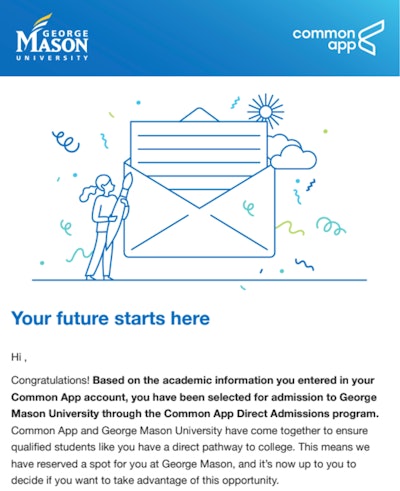For a prospective college student beleaguered by the complexities of the application process, direct admissions is like a dream come true. If their GPA or standardized test scores are high enough, colleges with direct admissions programs will send them acceptance letters without their even having to apply. All that’s required of them is to return a simplified form with no supplemental questions or essays. A fee waiver is included, to boot.
 Part of a direct admissions acceptance letter from the College App and George Mason University
Part of a direct admissions acceptance letter from the College App and George Mason University
The study, led by Dr. Taylor Odle, an assistant professor of educational policy studies at the University of Wisconsin-Madison, and Dr. Jennifer Delaney, an associate professor of higher education at the University of Illinois, Urbana-Champaign, was based on data from a direct admissions pilot program that has been run by the Common Application since 2021. Odle and Delaney studied the direct admissions process at six schools that are part of the pilot, some private, some public, some small, some large, and all ranging from moderately selective to open access. Two were Historically Black Colleges and Universities (HBCUs), and two were Hispanic Serving Institutions (HSIs). Data was obtained on the choices of almost 32,000 students.
As might be expected, receiving a near-automatic acceptance from a college made students likelier to follow up. The likelihood of a student “applying”—by sending back the simplified form—to a school that had directly accepted them doubled, to almost 4%. Getting a direct admissions letter also made students more likely to apply to any college at all, an increase of 12%.
Odle said that students tend to figure, “Once I’m in there, and I’ve already been admitted, why don’t I just go ahead and submit another application?”
Most underrepresented groups experienced bigger increases in the likelihood of application. Whereas white students who received a direct admissions offer were 2.4 percentage points more likely to apply to college anywhere, Black students were 3.7 points likelier. Non-first-generation students were 2.5 points likelier to apply, compared to 3.2 points for potential first-generation students.
 Dr. Taylor Odle, assistant professor of educational policy studies at the University of Wisconsin-Madison
Dr. Taylor Odle, assistant professor of educational policy studies at the University of Wisconsin-Madison




















